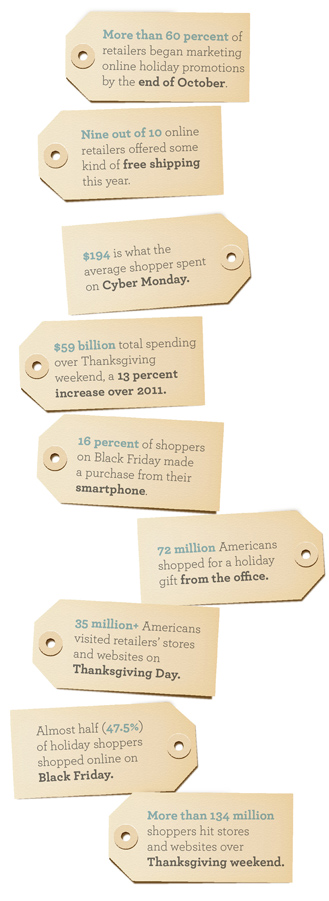The shopping and spending trends and conclusions of 2012.
It was an earlier start than usual this holiday season. And there were more shopping days between Thanksgiving and Christmas than last year. So hopes were high. But it turned out to be the imperfect holiday for many retailers. Because, when the fat lady sang, retail sales results were up only three percent compared to 2011, well under the 4.1 percent forecasted by the National Retail Federation. Reflecting a season that was “peak-ed” to say the least.
Retailers at the high end and low end seemed to fare better than those in the middle. Tiffany’s saw four percent tear-over-year growth, Nordstrom’s posted an 8.6 percent growth and TJ Maxx saw six percent growth. All the while, Kohl’s saw only 0.7 percent growth. Overall, electronics, clothing and home goods purchases increased a paltry 0.7 percent, as well. The bright spot in retail was online sales, which were up 14 percent.
But, despite less than stellar numbers, there were some very clear takeaways from the 2012 season.
Sales for November and December account for 20 to 40 percent of U.S. retailers’ annual revenue.
Black Friday isn’t what it used to be.
Though it started Thursday this year, it has become more of a media event and family entertainment activity than a major indicator or driver of the season’s sales.
Leveraging mobile technology can make the experience better, faster and easier – in-store, as well as online.
Macy’s added a GPS tracking system app (in order to help customers make their way around) for its massive Herald Square flagship store in Manhattan. They saw a 19 percent growth in mobile users and refer to the app as a “silent salesperson,” helping customers find products, while interacting with the retailer through the use of digital content.
Target made it easier for parents to shop for their kids, with them in tow, through an app that let them scan a QR code next to the 20 most popular toys, pay on the phone and have them shipped for free.
 It was more evident than ever this year that mobile technology has changed shopping behavior, well beyond show-rooming. Nearly one in five holiday shoppers played Santa this year through their smartphones or tablets.
It was more evident than ever this year that mobile technology has changed shopping behavior, well beyond show-rooming. Nearly one in five holiday shoppers played Santa this year through their smartphones or tablets.
Omnichannel strategies are becoming a priority.
Retailers who cater to the needs of the stop-start-shopper (those who flip from smartphones to tablets to PCs and move across a number of channels and touchpoints over an undefined period of time before making a purchase), are converting at higher levels, increasing loyalty and growing basket spend.
The fact is, various physical and online eCommerce channels are blending together and online marketing efforts are influencing both in-store and online purchases. So retailers need to focus on the seamless integration of all the different ways they interact with customers – bringing together physical stores, websites, social media, mobile and more.



